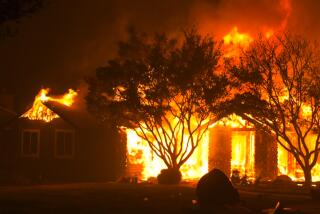Fake Stories Coerced Insurers, Aide Says
SACRAMENTO â California Insurance Commissioner Chuck Quackenbush used fake sensational news stories to coerce major insurance companies into making contributions to controversial earthquake foundations, a senior staff member has admitted.
The phony news stories, purported to be what the Los Angeles Times might publish on its front page, were enlarged and presented to the insurance companies as a preview of what they might see if they did not cooperate, the staffer said.
Contradicting his testimony before the state Assembly Insurance Committee last month, Deputy Commissioner David Langenbacher said in a May 10 letter to the committee that âblow-ups were included as examples of possible articles that might reflect potential outcomes of our negotiations.â
The scene described in Langenbacherâs letter matched scenarios of attempted intimidation reported by insurance company executives when they met with Quackenbushâs staff, notably Chief Deputy Commissioner William Palmer, late last spring to discuss Northridge settlements.
Officials from one company were so repulsed by the scene that they stormed out of the meeting room.
âOur folks were just completely baffled by the presentation and took their leave,â said William Sirola, a spokesman for State Farm Insurance.
Six companies eventually agreed to Quackenbushâs proposal, resulting in donations of $12.8 million to two foundations.
One of the foundations, the California Research and Assistance Fund, spent $3 million of that money to produce and air television spots featuring Quackenbush. An additional $1.4 million went to minority organizations, many of which were located in Sacramento, where Quackenbushâs wife had tried unsuccessfully to win a seat in the state Senate.
So far, none of the money has gone to victims of the Northridge earthquake as Quackenbush, in numerous news releases, said it would.
At an Assembly Insurance Committee hearing April 27, Langenbacher was asked by Assemblyman Tom McClintock (R-Northridge) if during negotiations insurance companies had been presented two proposed news releases. One release reported that heavy fines had been levied against them and the other, that they were contributing to a private charity.
Langenbacher said he didnât remember seeing two news releases. âAre you saying this did not occur, or you do not know?â McClintock pressed. Langenbacher said his recollection was that it âdid not occur.â
In the letter to the committee, Langenbacher said he believed he had honestly replied to the question but upon making inquiries had learned of the blow-ups of fake news articles.
He attached to his letter copies of the phony stories, which carry the heading âLos Angeles Times--Front Pageâ and a Sacramento dateline.
McClintock said in an interview Tuesday that he found the tactics used by the department to be âan abuse of power.â
âI found the tactic disturbing since I first heard allegations that companies were brought into the commissionerâs office and threatened with legal action unless they contributed to private foundations,â he said. âI continue to be greatly disturbed by that tactic.â
The implied threat in both fake news stories was that if the companies did not agree to donate to the foundations, Quackenbush would hold hearings and publicize confidential surveys conducted by his department on the handling of Northridge earthquake claims by major insurers.
The headline on one mock story said, âReport Detailing Claims Handling Problems Made Public.â
âCommissioner Quackenbush today announced the results of an investigation into the claims handling practices of (INSERT INSURANCE COMPANY NAME HERE) would be made public. This is the first time such a report has been made available to the public,â the phony article said.
The fake story went on to say, âCommissioner Quackenbush took this unprecedented step because (INSERT INSURANCE COMPANY NAME HERE) refused to come to agreement over how best to resolve numerous outstanding issues related to the companyâs handling of Northridge earthquake claims. Department sources say the company was given an opportunity to resolve these issues during meetings held earlier this week.â
The story then quotes Quackenbush as saying he has âhad enough of recalcitrant insurers that refuse to do the right thing.â
The second fake story carried a headline: âInsurance Company Refuses to Resolve Outstanding Northridge Claims Handling Issues--Commissioner Orders Company to Hearing.â
All six companies eventually agreed to contribute to the foundations established by Quackenbush. The surveys, which were reviews of claims settlements made by four of the companies, were never made public.
But copies were reviewed by The Times. They showed that 25% to 75% of the claims examined by the department had not been handled properly.
Not Necessarily the News
California Insurance Commissioner Chuck Quackenbush used fake news stories to pressure insurance companies into making contributions to controversial earthquake foundations, one of his staff members admitted. Below is a sample of one of the phony stories.
*
* HOLOCAUST FUNDS
Quackenbush has yet to collect money for Holocaust survivors from Dutch insurance firms. A3
More to Read
Sign up for Essential California
The most important California stories and recommendations in your inbox every morning.
You may occasionally receive promotional content from the Los Angeles Times.










